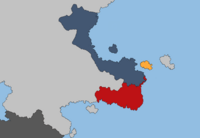Labradoria
United Kingdom of Labradoria and Nassaua | |||||||
|---|---|---|---|---|---|---|---|
| 1766–1819 | |||||||
 Labradoria in 1810, indicated in red. | |||||||
| Capital | Labrador | ||||||
| Common languages | Anglish and Variot | ||||||
| Demonym(s) | Labradorian | ||||||
| Government | Monarchy | ||||||
| Monarch | |||||||
• 1704-1725 | William I | ||||||
• 1725-1756 | William II | ||||||
• 1756-1762 | Anne | ||||||
• 1762-1770 | William III | ||||||
• 1780-1801 | Frederick I | ||||||
• 1801-1819 | William IV | ||||||
| Prime Minister | |||||||
• 1769-1782 | Henry Beaumont | ||||||
• 1782-1795 | Charles Landstadt | ||||||
• 1795-1803 | George Morris | ||||||
| Legislature | Continental Assembly | ||||||
| House of Governors | |||||||
| House of Delegates | |||||||
| History | |||||||
• Establishment of the Colony of Delamaria | 1766 | ||||||
• Crown Colony of Great Anglia | 1679 | ||||||
• Royal Dominion of Great Anglia | 1704 | ||||||
• Instrument of Independence from Great Anglia | 1766 | ||||||
• Union with Nassaua | 1811 | ||||||
• Formed the 2nd Federation of Delamaria | 1 January 1819 | ||||||
| Currency | Labradorian Pound | ||||||
| |||||||
| Today part of | Delamaria | ||||||
| |||||||
Labradoria, known as the Kingdom of Labradoria from 1766 to 1811, and as the United Kingdom of Labradoria and Nassaua, was a country located mostly in Southern Delamaria from 1766 to 1819, when it formed the Federation of Delamaria with Lysian Columbia. The nation was a constitutional monarchy under the House of Bohun-Odell, a cadet branch of the House of Odell, which ruled with 6 monarchs from 1704 to 1819.
Prior to its independence Labradoria was a Royal Dominion of Great Anglia, with a hereditary Vice Roy as its leader, which would initially be appointed by the Anglian monarch, the first Vice Roy was William Bohun-Odell, the nephew of the Anglian Monarch through his sister. In 1766 an independent Kingdom of Labradoria was declared with the Bohun-Odells as its ruling house, this lead to Anglian loyal soldiers stationed at Fort Meyer attempting to seize power by taking the political and military leaders meeting in Felderling hostage, with an ill-equipped force left without leadership failing to take control of Beaumont Palace where the hostages were being kept, an appeal was sent to local militias to help break through the defensive structures built around the palace, the largest militia nearby was the Vandergart Republican Army, led by Charles Landstadt. Landtstadt successfully broke into the Palace and rescued the hostages with minimal casualties, an order was sent to kill the hostages only minutes prior to their rescue, though the soldiers guarding them were afraid they would be later tried for doing so. After this many republican sentiments were still prevalent, despite the republican leadership working with the monarchists. A major republican faction known as the Pan-Delamaric Republican Party had thousands of members and threatened to overthrow the new monarchy. Therefore, in 1780 King Frederick I issued the Democratic Proclamation, granting major powers to the Governor-General, and expanding voting rights to most men and some upper-class women. The Proclamation also significantly decreased the powers of the nobility, rendering their positions to mere titles, without any real control over the lands within their domains.
In 1804 the Delamarian War occurred between Labradoria and Lysian Columbia after the latter claimed the Kingdom of Nassaua and the Territory of Hyannis. After five years of fighting Labradoria and Nassaua emerged victorious, and two years later Nassaua decided to join Labradoria to form the United Kingdom.

